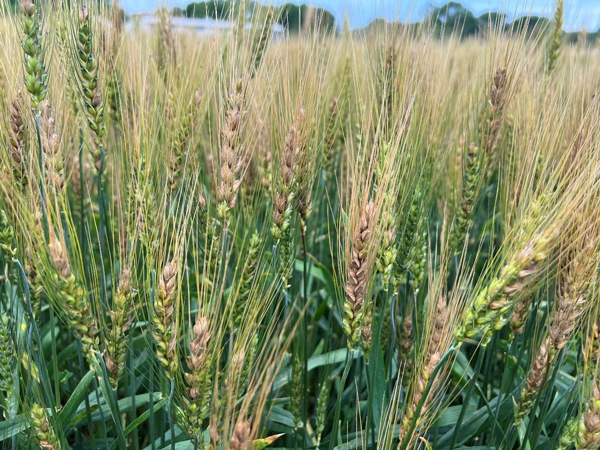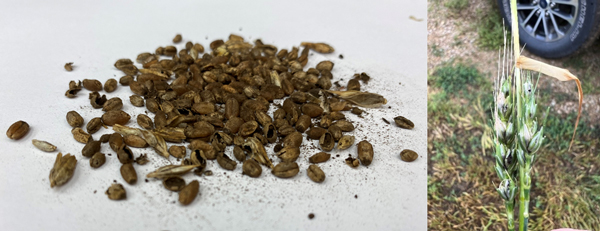Seed treatments are an important part of wheat production in Kansas. An updated version of the K-State publication MF2955, Seed Treatment Fungicides for Wheat Disease Management 2023 is now available at: http://www.ksre.ksu.edu/bookstore/pubs/MF2955.pdf
This updated publication features updated product efficacy information, recommendations for setting seed treatment priorities, considerations for seed treatment success, a key to common seed treatment active ingredients, and a list of some of the more common seed treatments labeled for use in Kansas.
It is important to make sure the seed treatment chosen matches the diseases and pests you are looking to control. Most seed treatments available for wheat in Kansas include one or more fungicide active ingredients (FRAC CODES 3 or 11) that provide protection against a suite of seedborne fungal diseases (common bunt, loose smut, flag smut) as well as soilborne seedling diseases which may result in poor emergence or damping off. These products may also provide early-season suppression of foliar diseases like powdery mildew and rusts. These products may provide suppression of root and foot rots but will not provide full season control against spring infections. Some seed treatments include metalaxyl or mefenoxam (FRAC CODE 4) which control soilborne oomycete diseases like Pythium root rot. Some products also contain insecticides like imidacloprid or thiamethoxam for early-season control of aphids, wireworms, and other insect pests. It is important to note that seed treatments will only provide protection from diseases and pests for approximately 30-45 days after planting and do not provide disease or insect control through the spring months. It is important to take note of grazing restrictions if the seed treatment contains an insecticide.
Adequate seed coverage is critical to ensure the maximum efficacy of any seed treatment products. Seed that is heavily contaminated with chaff or dust may limit the adherence of seed treatments. In addition, if too much clumping of the product occurs, the seed may not be uniformly covered and may not flow well through planting equipment.
Seed treatment priorities in 2023
Fusarium head blight (scab) in northwest Kansas: Fusarium head blight is a serious disease that can result in direct yield loss, discounts, and rejections due to mycotoxin (DON) accumulation, and loss of seed viability. Seed saved from fields with Fusarium head blight may face emergence issues in the fall. Luckily, seed treatments and proper seed cleaning can greatly reduce stand loss in these seed lots. In 2023, there were higher-than-normal levels of Fusarium head blight in northwest Kansas due to untimely rainfall while wheat was flowering (Figure 1). Affected seed lots should be tested for germination (recent eUpdate article on seed tests: https://bit.ly/3NK71Ts) and considered as candidates for a seed treatment containing a FRAC 3 or FRAC 11 fungicide (such as difenoconazole, prothioconazole, or tebuconazole).

Figure 1. Left: Field showing severe Fusarium head blight (scab) symptoms at the soft dough stage of development in 2023. Photo by Kelsey Andersen Onofre, K-State Research and Extension.
Fungicide seed treatments help keep seed-borne diseases such as smuts and bunts in check. Loose smut control and common bunt (Figure 2), sometimes called, “stinking smut”, can be controlled very effectively with most commercial treatments. Some regions of the state have struggled with these diseases in recent years. If you are planning to keep seed that is known to have or has been exposed to common bunt, it is critical to use a fungicide seed treatment or to purchase certified seed to avoid problems in the future.

Figure 2. Left: A wheat seed lot with severe common bunt (also known as “stinking smut”). When common bunt infection occurs, the grain is entirely replaced with black fungal spores, leaving only the outer seed coat. These “bunt balls” can easily break open and infect otherwise healthy seed. Right: Infected plants prior to harvest. Photos by Kelsey Andersen Onofre, K-State Research and Extension.
Seed treatments can aid stand establishment when planting wheat after soybean harvest, even on seed that has high test weight and good germination. Planting wheat late into cool, wet soils often delays emergence and reduces the tillering capacity of wheat seedlings. This reduced tillering capacity diminishes the plant's ability to compensate for stand loss and maintain yield potential.
Kelsey Andersen Onofre, Extension Wheat Pathologist
andersenk@ksu.edu